Installing a faucet in the bathroom: device and step-by-step installation guide
Sometimes it seems that installing a faucet in the bathroom can only be done by professionals. Especially if this question was presented to an inexperienced owner.Everything looks complicated, incomprehensible, and this makes it even more frightening. But you can cope with this task yourself, just having a little understanding of the intricacies of the process.
We will tell you how not to make a mistake when choosing a mixer, what parameters to pay attention to when purchasing a device, and also provide step-by-step instructions for installing it.
We supplemented all stages of assembly and installation with detailed diagrams and visual photographs. For a better understanding of the process, video clips with instructions on how to install the crane are provided.
The content of the article:
Subtleties of choosing a bathroom faucet
The need to install a faucet in the bathroom may arise for various reasons - due to a full-scale renovation, breakdown of an old familiar unit, or simply wanting to change a boring model.
If this is one of the last two options, then dealing with the issue will be quite easy. The main thing is to calmly understand the device, installation features and the most common errors.
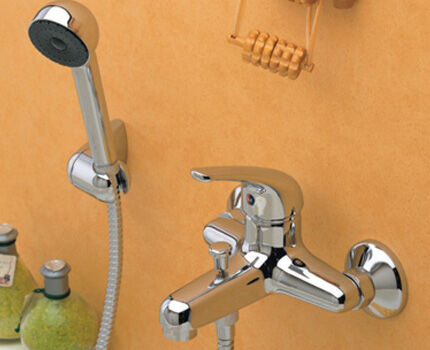
The first thing to do is choose a new faucet or, as users often call it, a faucet.After all, now almost no one installs a separate tap for cold water and a separate tap for hot water.
It is convenient for the consumer to use the mixer - it is practical and beautiful. Thanks to the variety of offers on the market, you can choose a model of any style to suit different interiors.
Faucets: they are so different...
Manufacturers offer a variety of models, radically different in price. First you need to decide which model is needed.
Depending on how the mixer will be installed, they are all divided into three types:
- with horizontal installation, when it is to be installed on a horizontal surface;
- from vertical – when the installation takes place in a vertical plane;
- built-in when all parts wall mounted.
Horizontally oriented mixers are expected mount on the side of the bath or shells. Vertical - on the wall. Built-in ones are quite a rare phenomenon for our consumers. This is difficult, very expensive, impractical for standard apartments and requires the participation of professionals.
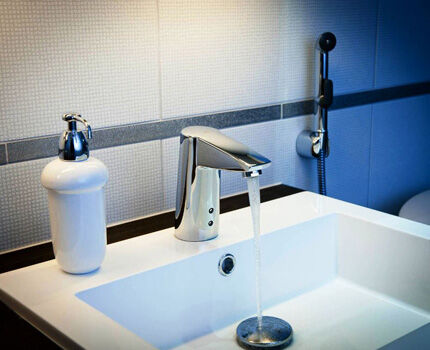
Often, at least two taps are used in the bathroom - one for bathing and one for the washbasin. Here you have to choose the option that is suitable for a particular room. If a full-scale repair with redevelopment is not planned, then all that remains is to buy a new crane of the same type as the old one installed.
Depending on the internal structure, mixers are divided into the following types:
- two-valve;
- lever;
- thermostats;
- contactless.
The most favorite option of many customers is two-valve.It is perhaps difficult to find an adult who does not understand what we are talking about. This type of faucet has two valves, responsible for hot and cold water, respectively. They use rubber gaskets or ceramic discs as seals.
The second option is more preferable - it has a longer service life. But, when hard water with a large number of impurities flows from the pipes, and individual cleaning filters are not installed in the apartment or house, then it is more advisable to choose the option with rubber gaskets.
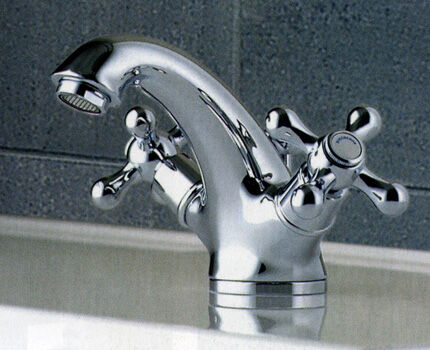
A lever-type mixer has only one tool for adjusting the water temperature - a lever. The process of mixing water occurs by turning the lever in one direction or the other.
Due to the ease of use of such models and moderate cost, the demand for them is constantly growing - manufacturers offer a wide range selection of single lever mixers. As for installation, it is also not particularly complicated.
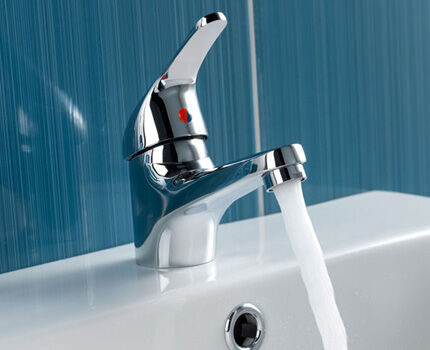
More expensive option - mixer-thermostat. It does not require constant human participation in adjustment and configuration. All you need to do is set the desired water temperature once.
This type of tap is absolutely not suitable if hot water is often turned off in a house or area - the thermostat will block the supply of cold water. So, coming home from work in the evening and wanting to wash your hands, you can get a lot of unpleasant emotions and use a lot of obscene expressions.
Although this is a very convenient option for swimming - when there are sudden changes in water temperature and you need to constantly adjust the desired temperature, the thermostat will be a real godsend.
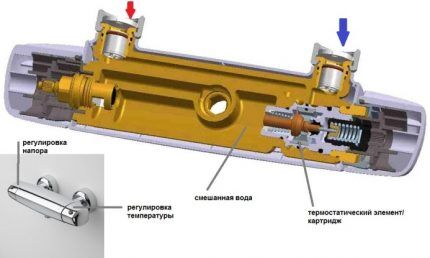
The touchless type of faucet is most often chosen for installation in public places. It is used for home use in rare cases - when it is the embodiment of an original design idea or it is simply interesting to try something new in your bathroom.
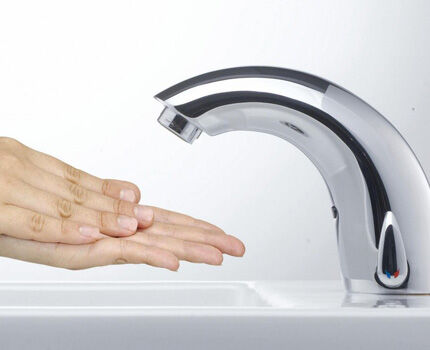
Faucet materials
If you focus on the price range, the cheapest are models made from an alloy of aluminum and silicon - silumin. They are much lighter in weight and have a short warranty period. It rarely happens that such a mixer will be used much longer than this period.
More expensive options are made from a multicomponent copper alloy - brass. They are immediately distinguished by their impressive appearance and weight, which significantly exceeds the weight of their silumin counterparts.
When choosing a faucet for yourself, it is better to avoid those models in which nickel was used in the coating. This may cause health problems. It is good to choose options with chrome plating. Moreover, they compare favorably with colors and imitation of various metals.
The most expensive faucets are designer ones. They are, as a rule, very original and can give a special mood to the interior of the bathroom.It is this quality that significantly affects the final cost, which can reach fantastic proportions.
By choosing this option, you can be sure that no one you know has the exact same faucet installed in their bathroom.
As for the variety of models, for a bathroom sink it is more advisable to choose not only a beautiful option, but also a convenient one. You should pay attention so that during the process of washing your hands and washing your face, it is convenient to place your palms under the stream of water.
Here, the original low models with a small tap are an order of magnitude inferior - after all, it is completely inconvenient to perform daily hygiene procedures with such a tap. A mixer without a tap is also not the best option for a washbasin, but for bath procedures it may be just right.
Step-by-step installation of a mixer yourself
Having decided to install the faucet yourself, you must first buy it, then prepare the necessary tools and, having unpacked the box with the new faucet, you can begin the installation process.
But first, let's talk a little more about what it's like mixer device, used for bathroom.
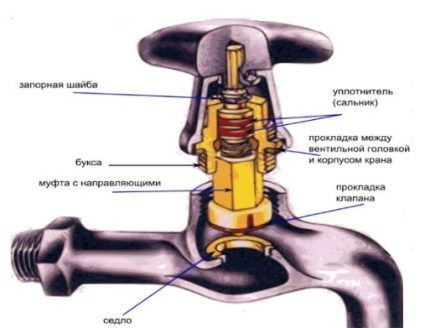
A traditional faucet typically consists of two valves that control the flow of hot and cold water into the mixing chamber. To ensure their operation, such parts as a lock washer, a special seal - oil seal, gaskets, axle box, coupling with guides, and a seat are used.
All this is in an already assembled state, which does not require additional attention when installing a new mixer.
Step 1. Checking the product contents
Having chosen the best option for your bathroom, you will have to consider the contents of the box - open all the bags and boxes that are in the packaging with the purchased model.
If this is a bath mixer, then in the bag you can find a shower head, a flexible hose for it and an additional fastening - a holder rod.It must be mounted on the wall, the side of the bathtub, or on the faucet body to hold the watering can.
Also a faucet with valves or a lever, which must be connected to the rest of the parts according to the instructions. The kit necessarily includes a set of sealing gaskets, nuts, decorative reflectors for the wall, adapter eccentric bushings and a spout for the tap.
Having considered all the components, it is not at all necessary to study from which spare parts they are assembled. It is enough to carefully screw everything on, following the instructions supplied by the manufacturer in the kit.
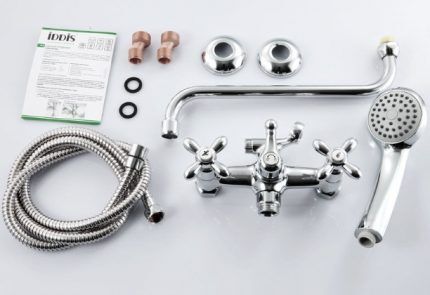
Step #2. Required tools for installation
Before starting installation, it is best to prepare all the tools and parts that may be useful:
- box with mixer and all its components;
- pliers, building level, tape measure, adjustable wrench, open-end wrenches;
- flax tow and Unipak/silicone paste or special sealing fum tape;
- soft cloth/small towel, paper napkins/toilet paper.
All of these components will be needed during the installation process. It would be good to use tools without teeth, but if there are none, then in order not to scratch the top coating of the devices and its parts, a cloth or towel should be placed on them.
This technique will help protect against external mechanical damage, which is especially important for home craftsmen installing a mixer for the first time.
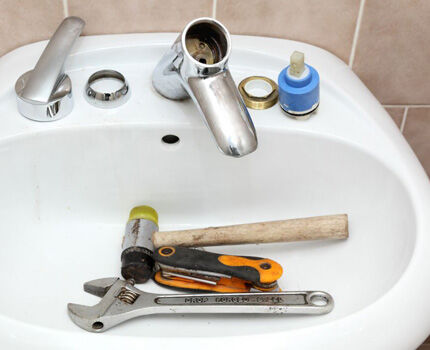
The paper will be useful to thoroughly wipe everything after installation and check if anything is leaking.If so, then you will have to disassemble everything and reassemble it, not forgetting to tightly screw each connection and put gaskets on each nut.
Step #3. Preparing the site for installing the crane
Before installing a mixer, do not ignore generally accepted standards. So, if the faucet is installed to simultaneously service a bathtub and washbasin, then, according to the standards, the installation height must be at least 1 m from the floor level.
Depending on the functions performed and location, the height will be different:
- 80 cm from the floor level - for the mixer serving the bathtub;
- 20 cm from the side of the washbasin - for taps on the sink;
- not lower than 120 cm from the floor - if faucet for shower.
Another point that requires attention is the installation location of the crane. Depending on it, the main installation process will differ. If this is simply replacing an old faucet with a new one, then first you need to remove the used one.
In the event that a renovation is to be carried out with the complete replacement of old water pipes with new ones, you need to carefully consider where the plumbing will be installed in order to provide for the installation of water sockets in the appropriate places.
To install the fittings to which the mixer will be attached, you need to carefully calculate the distance between the cold and hot water pipes - exactly 15 cm. It is important that they are strictly horizontal to each other.
Also, the fittings should not be too long - they should end flush with the bathroom cladding material or be a couple of mm shorter.
Having completed the work of removing the fittings, you can begin the standard installation of mixers.
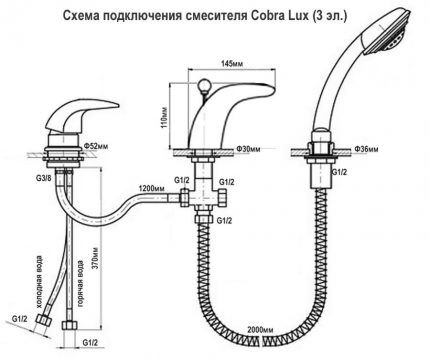
Step #4. Mounting a faucet on a wall
The most important thing in installing faucets yourself is not to overtighten the nuts so that nothing bursts or breaks. After all, buying new parts for a new mixer is extremely unpleasant and annoying. Therefore, there is no need to rush and tighten everything tightly - it is better to twist it a little tighter later than to run to the plumbing store.
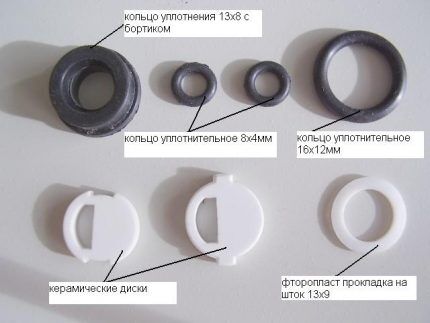
Vertical type faucets are typically installed directly on the wall, from which water pipes with cold and hot water come out. Ideally, the distance between water outlets should be at least 15 cm, but almost always a persistent discrepancy can be found here.
To correct this shortcoming, special adapter bushings - eccentrics - are designed. These are slightly curved parts with threads on both sides. It happens that the length of the eccentrics included with the mixer is not enough. In this case, you need to buy these longer spare parts separately.
The first step before starting installation is to turn off the taps on the hot and cold water pipes, using your hands or keys of the appropriate size - it all depends on which taps are in a particular room.
Then, after making sure that no water is flowing, you can remove the old faucet. To do this, you will need to use prepared tools, unscrewing the nuts and removing all the old parts one by one.
Having reached the water pipes, some craftsmen leave the old eccentrics without changing them.But, they definitely check the suitability for further use.
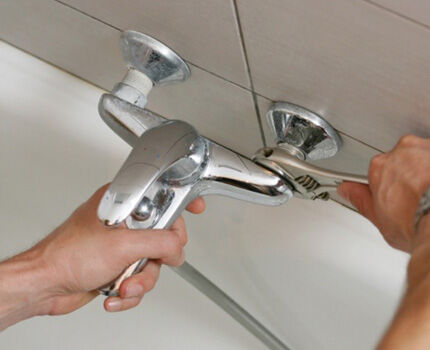
Before screwing in the eccentric bushings, you should carefully wrap a sealant - tow - around the threads. Then apply a thin layer of silicone or Unipak paste on it.
After screwing in these parts, you need to check their horizontal position relative to each other using a level and, and with a tape measure, check the distance between them. If everything is in order, then you can proceed with further assembly. Now we need to screw on the decorative reflective cups that cover the holes in the wall.
Afterwards, you can connect the mixer inlet pipes with eccentric bushings using the union nuts supplied in the kit. Be sure to place a gasket under the nuts. After carefully tightening everything, connect the spout and a flexible shower hose, to which the watering can is screwed.
Now we need to check whether everything is installed properly and whether there are any leaks. You need to open the taps responsible for supplying water to the apartment and turn on the newly installed mixer.
It is better to check first with a small pressure, then increase the power of the jet until it stops. If everything is fine, then be sure to switch the water to the shower hose and check how this part of the system works.
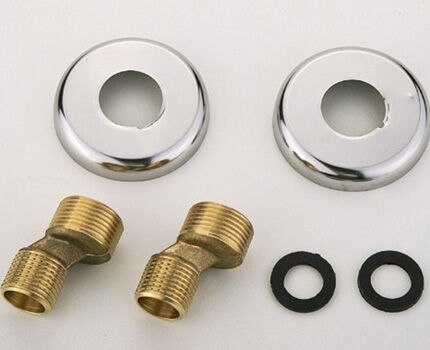
If there are no leaks, you can congratulate yourself on your first independent, and most importantly, correct installation.If there is a leak, then you have to carefully look at where exactly it is happening, then turn off the water again, remove everything that was installed, and carefully repeat the process again.
It is important to carefully inspect each gasket and nut - perhaps some fastening was over-tightened, which led to damage to one of the parts. The tow on the eccentrics will also have to be re-wound.
Step #5. Installation of a horizontal type mixer
Having figured out how to independently install a vertical type faucet in the bathroom, we will consider the option of horizontal installation. It differs from the previous one in that installed on the side of the washbasin or bathtubs, where special holes are provided for the mixer.
Sometimes there are no such holes, but the width of the sides allows for this type of installation. This is where you have to work hard - cut holes for the faucet on the bathtub shelf yourself.
This work must be done very carefully so as not to damage the coating of the container. Home craftsmen have become adept at cutting holes not only in acrylic, but also in steel and cast iron bathtubs without damaging the enamel.
The main convenience of this type of mixer is that the location of the water pipes can be at any distance. This will not interfere with installing the selected faucet model - it must be connected using flexible hoses or copper pipes.
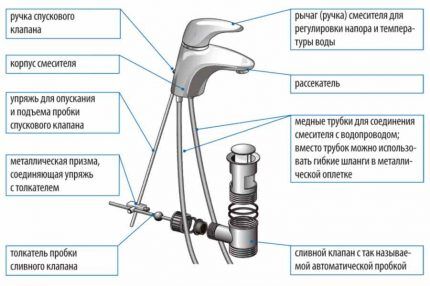
Having screwed the horizontal mixer into the special holes in the plumbing, it must be additionally secured with a pressure washer and a gasket.Flexible hoses must first be threaded into the hole on which the faucet will be installed.
Now the hoses must be connected to water pipes with cold and hot water, using tow or special fum tape as a seal.
After these manipulations, all that remains is to check the quality of your work - open the taps that shut off the water supply to the apartment and turn on the mixer. If nothing is leaking anywhere, the faucet is installed correctly. Otherwise, you need to disassemble everything and do all the work again.
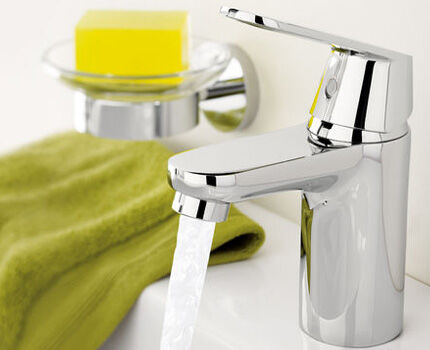
Conclusions and useful video on the topic
Detailed video on how to choose a mixer:
A little about the design of a two-valve and lever-type mixer:
Video recording about self-installation of a faucet in the bathroom:
Video about the main subtleties when installing the mixer yourself:
Having found out the main nuances of installing a faucet in the bathroom, you can safely begin replacing it yourself. The most important thing is to do everything consistently and carefully so as not to damage the parts by using excessive force.
Before installation work, it is necessary to shut off the water pipes so as not to flood the neighbors below. Self-installation will take a little time and will save on the service of a plumber.
Do you have experience replacing an old faucet or installing a new faucet? Or still have questions on the topic? Please share your opinion and leave comments. The contact form is located below.




Single-lever faucets are annoying, you have to stand there for half an hour to adjust the desired temperature, who even invented them? Two-valve is already a classic, comfortable.But there is also a drawback: they are always leaking, you don’t have time to change the gaskets. Of all the variety, there really is nothing to choose from, even if you hang a washbasin like in a village) As for installation, it’s already easier, even a beginner can assemble and install the required faucet.
buy a normal faucet... and forget it for centuries! I have had Czech for at least 18 years! without any repairs!!!! Set it... and forget it! otherwise it was previously Soviet….- I was hesitant to change the gaskets.
I just bought a Hansgrohe bathtub faucet, it’s so heavy! they installed it themselves.
I decided to abandon the two-valve mixer - the water consumption was too high (I turned off one tap, then the second - and the water kept flowing). The contactless one is good, but still expensive and not very suitable for our hard water. I bought and installed a lever one instead of the two-valve one that was there before. Installed vertically on the wall. It went well - all the nuts are intact.
There is an error in the text. Where installation of a vertical type is described, it cannot be placed on the wall, only in the hole of the bathtub, or there will be small towns. But you can’t put a horizontal type on the side of a bathtub, since the outlets for hot and cold water go in a horizontal plane and are connected to eccentrics in the wall. But in the article everything is mixed up.
Hello, please tell me, I installed a new two-lever faucet in the bathroom, the following problem arose: when you turn on the water to the tap, water flows from the shower, but when you switch to the neck, the tap does not flow. What is the problem and how to solve it? The mixer is new.
I'll share my experience. It was necessary to do a sink at the dacha.We bought the sink itself, I laid the tiles on the wall (this was my first time, that’s why it was so crooked, then I made it flat), we took the countertop from the computer desk, cutting a hole in it for the sink. Now it's the turn of the mixer. My children are very smart, and more than one mixer has died with them. Therefore, a brilliant idea came to mind - see the photo.
There are a lot of details, but I didn’t find out the most important thing: why screw the faucet if there are no pipes in the wall? Just tiles.
And how to screw new pipes onto old Soviet ones? How to make carvings on old ones if they run along the wall? And the fact that you need to turn off the water and check the tightness is already clear...
I read it. But, if you are from St. Petersburg, then I recommend service center 007. I called a specialist, the master did everything, and it wasn’t even expensive.
Here they write that the length of the eccentrics from the kit is sometimes not enough. So the “authors” are clearly not in the subject. In the vast majority of cases, the eccentrics included in the mixer kit are much longer than required. And a huge problem for the owner will be precisely finding short eccentrics, which are extremely rare on sale, and finding them is a very big success. In all other cases, a faucet that looked beautiful on a stand in a store (on a short holder) will recede several centimeters from the wall at home. It’s so aesthetically pleasing, damn it, that in the comments there will be only swear words towards the manufacturers.
I bought a new mixer. The kit includes eccentrics, which I do not need, since the distance between the hot and cold water inlets is normal - 15 cm. The thread for the new nuts is also suitable.Why impose eccentrics that increase the cost of the mixer? Those who need them can always buy them separately in the same store.